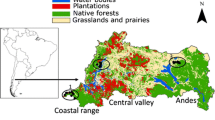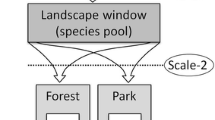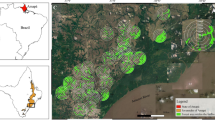Abstract
Nearly 40% of the remaining Atlantic Forest in southern Bahia state, Brazil, is a rustic agroforest of cacao (Theobroma cacao). These traditional shade plantations, locally known as ‘cabrucas’, are habitats for forest dwelling species. Here we investigated the potential role of this traditional crop as a support for bat assemblages in southern Bahia, establishing the extent to which the bat community structure found in this agricultural system is influenced by the proximity of forest tracts. We compared the bat community attributes (richness, diversity and dominance) and species-level response (capture frequency) between native forest tracts and shade cacao plantations located in two distinct landscapes, which varied in total amount of forest (patch sizes and total forested area) and in their proximity to forest tracts. The cabrucas contiguous to forest tracts showed a rich and abundant bat community, with samples showing capture rates, species richness, diversity and evenness significantly higher than those reported for forest tracts. This situation changes, however, when shade plantations are located at some distance from forest tracts ( > 1000 m). Bat communities in these isolated cabrucas are less diverse than those found in forests and nearby cabrucas, but in both cases, species usually associated with pristine habitats were found. These findings suggest that cabrucas per se are not forest surrogates, and their potential to harbor forest dwelling bat species is closely linked with the existence of nearby forest tracts that may act as a source for species populations. Therefore, the entire landscape should be considered for management, taking into account that maintenance of cabrucas together with the preservation and restoration of forest patches is probably direly needed if one wishes to conserve the bat diversity in southern Bahia for the long term.
Similar content being viewed by others
References
Alger K. 1998. The reproduction of the cocoa industry and biodiversity in Southern Bahia In: Proceedings of the First International Workshop of Sustainable Cocoa Growing, Panama City, Panama http://www.si.edu/smbc.
Alger K. and Caldas M. (1996). Cacau na Bahia: decadência e ameaca á Mata Atlântica. Ciência Hoje 20: 28–35
Alves M.C. (1990). The role of cacao plantations in the conservation of the Atlantic Forest of Southern Bahia, Brazil. Master Thesis. University of Florida, Gainesville, FL, USA
Araújo M., Alger K., Rocha R. and Mesquita C.A.B. 1988. A Mata Atlântica do sul da Bahia: situação atual, ações e perspectivas. Reserva da Biosfera da Mata Atlântica – MAB – UNESCO, Caderno no. 8.
Argôlo A.J.S. (2004). As serpentes dos Cacauais do Sudeste da Bahia. Editora da UESC, lihéus, Brazil
Bonaccorso F.J. (1979). Foraging and reproductive ecology in a Panamanian bat community. Bull. Florida State Museum Biol. Sci. 4: 359–408
Dechmann D., Kalko E.K.V. and Kerth G. (2004). Ecology of an exceptional roost: energetic benefits could explain why the bat Lophostoma silvicolum roosts in active termite nests. Evolut. Ecol. Res. 6: 1037–1050
Dietz J.M., Sousa S.N. and Billerbeck R. (1996). Population dynamics of golden-headed lion tamarins Leontopithecus chrysomelas in Una Reserve, Brazil. Dodo: J. Wildlife Preservation Trusts 32: 115–122
Dixo M.B.O. (2001). Efeito da fragmentação da floresta sobre a comunidade de sapos e lagartos de serapilheira no Sul da Bahia. Master Thesis. Universidade de São Paulo, Brazil
Donald P.F. (2004). Biodiversity impacts of some agricultural commodity production systems. Conserv. Biol. 18: 17–37
Estrada A., Coates-Estrada R. and Meritt D. (1993a). Bat species richness and abundance in tropical rain forest fragments and in agricultural habitats at Los Tuxtlas, Mexico. Ecography 16: 309–318
Estrada A., Coates-Estrada R., Montiel S., Curiel D. and Meritt D. (1993b). Patterns of frugivore species richness and abundance in forest islands and agricultural habitats at Los Tuxtlas, Mexico. Vegetatio 107/108: 245–257
Estrada A, Coates-Estrada R. and Meritt D. (1994). Non-flying mammals and landscape changes in the tropical rain forest region of Los Tuxtlas, Mexico. Ecography 17: 229–241
Estrada A. and Coates-Estrada R. (2002). Bats in continuous forestforest fragments and in a agricultural mosaic habitat-island at Los Tuxtlas, Mexico. Biol. Conserv. 103: 237–245
Faria D.M. 2002. Comunidade de morcegos em uma paisagem fragmentada da Mata Atlântica do sul da Bahia, Brasil Ph.D. Thesis. Universidade Estadual de Campinas, São Paulo, Brazil. http://www.institutodriades.org.br.
Fenton M.B., Acharya L., Audet D., Hickey M.B.C., Merriman C., Obrist M.K. and Syme D.M. (1992). Phyllostomid bats (Chiroptera: Phyllostomidae) as indicators of habitat disruption in the Neotropics. Biotropica 24: 440–446
Fenton M.B., Whitaker J.O., Vonhof M.J., Waterman J.M., Pedro W.A., Aguiar L.M.S., Baumgarten J.E., Bouchard S., Faria D.M., Portfors C.V., Rautenbach N.I.L., Scully W. and Zortea M. (1999). The diet of bats from Southeastern Brazil: the relation to echolocation and foraging behaviour. Rev. Brasileira Zool. 16: 1081–1085
Findley J.S. (1993). Bats – A Community Perspective. Cambridge University Press, Cambridge
Fleming T.H., Hooper E.T. and Wilson D.E. (1972). Three Central American bat communities: structure, reproductive cycles and movement patterns. Ecology 53: 555–569
Fleming T.H. (1991). The relationship between body size, diet and habitat use in frugovorous bats, genus Carollia (Phyllostomidae). J. Mammal. 72: 493–501
Gardner A.L. 1977. Feeding habitats. In: Baker R.J., Jones J.K. and Carter D.C. (eds.), Biology of Bats of the New World family Phyllostomatidae. Part II. Special Publication of the Museum, Texas Technical University, Lubbock, No. 13.
Gouvêa J.B.S., Silva L.A.M. and Hori M. 1976. 1. Fitogeografia. In: Diagnóstico Sócio-econômico da Região Cacaueira, Recursos Florestais. Vol. 7. CEPLAC/ Instituto Interamericano de Ciências agricólas – OEA. Ilhéus, BA, pp. 1–7
Greenberg R. 1998. Biodiversity in the cacao agroecosystem: shade management and landscape considerations. In: Proceedings of the First International Workshop of Sustainable Cocoa Growing, Panama City, Panama. http://www.si.edu/smbc.
Greenberg R., Bichier P., Angon A.C. and Sterling J. (1997). Bird populations in rustic and planted coffee plantations of Eastern Chiapas, México. Biotropica 29: 501–514
Haffer J. (1974). Avian speciation in tropical South America. Publ. Nuttall Ornithol. Club 14: 1–390
Hammer Ø., Harper D.A.T. and Ryan P.D. (2001). PAST: Paleontological Statistics software package for education and data analysis. Palaeontol. Electron. 4: 1–9
Handley C.O. 1987. New species of mammals from northern south America: fruit-eating bats, genus Artibeus Leach. In: Patterson B.D. and Timm R.M. (eds), Studies in Neotropical Mammalogy: Essays in Honor Philip Hershkovitz. Fieldiana Zoology, n.s., Chicago, Vol. 1382, pp. 163–172.
Handley C.O., Wilson D.E. and Gardner A.L. (1991). Demography and natural history of the common fruit batArtibeus jamaicensis, on Barro Colorado Island, Panama. Smithsonian Contribution to Zoology 511. Smithsonian Institution Press, Washington, DC, 173
Hill J.E. and Smith J.D. (1985). Bats: A Natural History. British Museum (Natural History), London, England
Jackson J.F. (1978). Differentiation in the genera Enyalius Strobilurus (Iguanidae): implications for Pleistocene climatic changes in eastern Brazil. Arquiv. Zool. 30: 1–9
Johns A.D., Wilson D.E. and Pine R.H. (1985). Rain forest bats: an uncertain future. Bat News 5: 4–5
Kalko E.K.V., Handley C.O. and Handley D. (1996). Organization, diversity, and long-term dynamics of a neotropical bat community. In: Cody, M. and Smallwood, J. (eds) Long term Studies in Vertebrate Communities, pp 503–551. Academic Press, New York
Kalko E.K.V., Friemel D., Handley C.O. and Schnitzler H.U. (1999). Roosting and foraging behavior of two Neotropical gleaning bats, Tonatia silvicola Trachops cirrhosus (Phyllostomidae). Biotropica 31: 344–353
Koopman K.F. (1993). Order Chiroptera. In: Wilson, D.E. and Reeder, D.M. (eds) Mammal Species of the World: A Taxonomic and Geographic Reference, pp 137–241. Smithsonian Institution Press, Washington, DC
Krebs C.J. (1989). Ecological Methodology. Harper & Row Publishers, New York
Kunz T.H. (1982). Roosting ecology of bats. In: Kunz, T.H. (eds) Ecology of Bats, pp 1–55. Plenum Press, New York
Laps R.R., Cordeiro P.H.C., Kajiwara D., Ribon R., Rodrigues A.A.F. and Uejima A.M.K. (2003). Aves. In: Rambaldi, D.M. and Oliveira, D.A.S. (eds) Fragmentação de Ecossistemas, pp 153–181. Causas, Efeitos Sobre a Diversidade e Recomendações de Políticas Públicas, MMA/SBF, Brasília, Brazil
Lee T.E., Hoofer S.R. and Den Bussche R.A. (2002). Molecular phylogenetics and taxonomic revision of the genus Tonatia (Chiroptera: Phyllostomidae). J. Mammal. 83: 49–57
Mainly B.F.J. 1991. Randomization and Monte Carlo Methods in Biology. Chapman and Hall
Majer J.D. (1978). The maintenance of the ant mosaic in Ghana cocoa farms. J. Appl. Ecol. 13: 123–144
Marinho-Filho J.S. and Sazima I. (1998). Brazilian bats and conservation biology: a first survey. In: Kunz, T.H.P. and Racey, P.A. (eds) Bat Biology and Conservation, pp 342–353. Smithsonian Institution Press, Washington, DC
May P.H. and Rocha R.B. (1996). O sistema agrossilvicultural do cacau-cabruca. In: Lopes, I.V., Filho, G.S.B. and Biller, D. (eds) Gestão Ambiental no Brasil: Experiência e Sucesso, pp. Fundacão Getúlio Vargas Editora, Brazil
Medellín R.A., Equihua M. and Almin M.A. (2000). Bat diversity and abundance as indicators of disturbance in Neotropical rainforests. Conserv. Biol. 14: 1666–1675
Moguel P. and Toledo V.M. (1999). Biodiversity conservation in traditional coffee systems of Mexico. Conserv. Biol. 13: 11–21
Mori S.A. and Silva L.M. (1979). The herbarium of the Centro de Pesquisas do Cacau’ at Itabuna, Brazil. Brittonia 31: 177–196
Mori S.A., Boom B.B., Carvalho A.M. and Santos T.S. (1983). Southern Bahian Moist Forests. Bot. Rev. 49: 155–232
Moura R.T. 1999. Análise comparativa da estrutura da comunidade de pequenos mamíferos em remanescentes de Mata Atlântica e plantio de cacau em sistema de cabruca no Sul da Bahia. Master Thesis. Universidade Federal de Minas Gerais, Belo Horizonte, Brazil.
Myers N., Mittermeier R.A., Mittermeier C.G., Fonseca G.A.B. and Kent J. (2000). Biodiversity hotspots for conservation priorities. Nature 403: 853–858
Pardini R. 2001. Pequenos mamíferos e a fragmentação da Mata Atlântica de Una, Sul da Bahia: processos econservação. Ph.D. Thesis. Universidade de São Paulo, São Paulo, Brazil.
Pardin R. (2004). Effects of forest fragmentation on small mammals in an Atlantic forest landscape. Biodiversity Conserv. 13: 2567–2586
Parrish J., Reitsma R., Greenberg R. 1998. Cacao as crop and conservation tool: lessons from the Talamanca Region of Costa Rica. Proceedings of the First International Workshop of Sustainable Cocoa Growing, Panama City, Panama. http://www.si.edu/smbc.
Perfecto I., Rice R.A., Greenberg R. and Van der Voot M.E. (1996). Shade coffee: a disappearing refuge for biodiversity. BioScience 46: 598–608
Perfecto I., Vandermeer J., Hanson P. and Cartin V. (1999). Arthropod biodiversity loss and the transformation of a tropical agro-ecosystem. Biodiversity Conserv. 6: 935–945
Pimentel D., Stachow U., Takacs D.A., Brubaker H.W., Dumas A.R., Meaney J.J, O’Neil J.A.S., Onsi D.E. and Corzilius D.B. (1992). Conserving Biological Diversity in agricultural/forestry systems. BioScience 42: 354–362
Power A., Flecker A.S. 1998. Agroecosystems and biodiversity. In: Proceedings of the First International Workshop of Sustainable Cocoa Growing, Panama City, Panama. http://www.si.edu/smbc.
Prance G.T. (1982). Forest refuges: evidence from woody Angiosperms. In: Prance, G.T. (eds) Biological Diversification in the Tropics, pp 137–157. Columbia University Press, New York
Rice R.A. and Greenberg R. (2000). Cacao cultivation and the conservation of biological diversity. Ambio 29: 167–173
Rolim S.G. and Chiarello A.G. (2003). Slow death of Atlantic forest trees in cocoa agroforestry in southeastern Brazil. Biodiversity Conserv. 13: 2679–2694
Room P.M. (1971). The relative distribution of ant species in Guana’s cocoa farms. J. Anim. Ecol. 40: 735–751
Rylands A.B. 1982. The behaviour and ecology of three species of marmosets and tamarins (Callitrichidae, Primates) in Brazil. Ph.D. Thesis. University of Cambridge, Cambridge, UK.
Sambuichi R.H.R. (2002). Fitossociologia e diversidade de espécies arbóreas em cabruca (mata atlântica raleada sobre plantação de cacau) na região sul da Bahia, Brasil. Acta Bot. Brasilica 16: 89–101
SAS Institute Inc. (1998). SAS/STAT User’s GuideVersion 6, 4th edn., Vol. 1. SAS Institute Inc, Cary, NC
Schroth G., Fonseca G.A.B., Gascon C., Vasconcelos H., Izac A.M. and Harvey C. (eds) (2004). Agroforestry and Conservation of Biodiversity in Tropical Landscapes. Island Press Inc, New York
Simmons N.B. and Voss R.S. (1998). The mammals of ParacouFrench Guiana : A neotropical lowland rainforest fauna. Part 1. Bats. Bull. Am. Museum Nat. Hist. 237: 1–219
Tejeda-Cruz C. and Sutherland W.J. (2004). Bird response to shade coffee production. Anim. Conserv. 7: 169–179
Thies W. and Kalko E.K.V. (2004). Phenology of Neotropical Pepper plants and their association with their main dispersers, two short tailed fruit-bats, Carollia perspicillata C. castaneaPhyllostomidae. Oikos 104: 362–376
Thomas D.W. and La Val R.K. (1988). Survey and census methods. In: Kunz, T.H. (eds) Ecological and Behavioral Methods for the Study of Bats, pp 77–104. Smithsonian Institution Press, Washington, DC
Torres J.A. (1984). Diversity and distribution of ant communities in Puerto Rico. Biotropica 16: 296–303
Underwood A.J. 1998. Experiments in Ecology: their Logical Design and Interpretation using Analysis of Variance. Cambridge University Press.
Vieira M.V., Faria D., Fernandez F.A.S., Ferrari S.F., Freitas S.R., Gaspar D.A., Moura R.T., Olifiers N., Oliveira P.P. and Pardini R. (2003). Efeitos da fragmentação sobre a biodiversidade: mamíferos. In: Rambaldi, D.M. and Oliveira, D.A.S. (eds) Fragmentacão de Ecossistemas. Causas, Efeitos Sobre a Diversidade e Recomendacões de Políticas Públicas, pp 126–151. MMA/SBF, Brasília, Brazil
Vizotto L.D. and Taddei V.A. (1973). Chave para identificação de quirópteros brasileiros. Editota Francal, São José do Rio Preto, Brazil
Western D. and Pearl M.C. (eds) (1989). Conservation for the Twenty-first Century. Oxford University Press, New York
Young A.M. (1994). The Chocolate Tree: A Natural History of Cacao. Smithsonian Institution Press, Washington, DC
Author information
Authors and Affiliations
Corresponding author
Rights and permissions
About this article
Cite this article
Faria, D., Baumgarten, J. Shade cacao plantations (Theobroma cacao) and bat conservation in southern Bahia, Brazil. Biodivers Conserv 16, 291–312 (2007). https://doi.org/10.1007/s10531-005-8346-5
Received:
Accepted:
Issue Date:
DOI: https://doi.org/10.1007/s10531-005-8346-5




